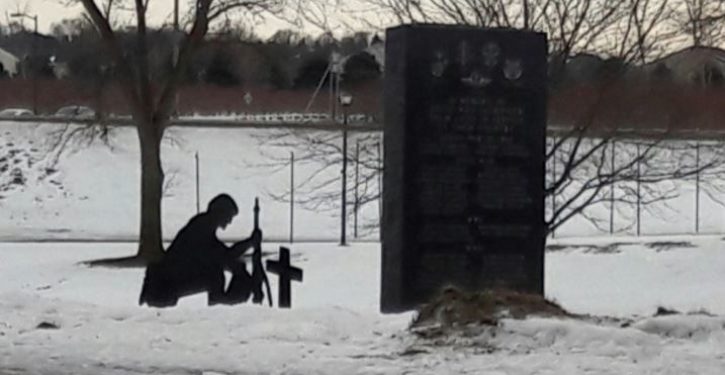
There’s no getting away from the fact that 2019 marks the 75th anniversary of everything that happened in the World War II year 1944. It was a year like no other, seeing the brutal siege of Leningrad lifted in January, the German defense broken in Italy, the Red Army advancing in Crimea and what is now Belarus, the start of daylight bombing over Berlin, and the Allied assault on Northern France, still one of the most remarkable combat actions in history. In the Pacific, the forces of the U.S. and the British Commonwealth converged on Southeast Asia, fighting for every inch against tenacious Japanese defenses in Burma, the Pacific island archipelagos, and Indonesia. In June 1944, ten days after the D-Day invasion began in Normandy, American B-29 Superfortresses operating from India conducted the first bombing raids against the Japanese home islands since Doolittle’s raid in 1942.
As intense and significant as World War II was, I think most Americans have had a strong sense that we stand today at the great interchange of an even larger history. World War II quite literally defined the human globe for more than half a century: it drew the geographic boundaries, set the framework of strategic expectations, delineated the moral causes and clash of ideologies for the ensuing decades. But the moving finger is writing. And we feel in our spirits: it is moving on.
It occurs to me, then, to offer a few small vignettes from an expanded store of memories as we pause to honor those who gave the “last full measure of devotion” in America’s service.
Will this presidential election be the most important in American history?
A 100-year anniversary
The first is a non-combat, non-war event whose 100th anniversary is today, 27 May 2019. On this day 100 years ago, one of a small flight of Navy amphibious planes completed a transatlantic crossing. It had never been done before, and it took specially built Curtiss biplanes, more planes than would actually finish the trip (only one of three, NC-4, made it all the way), a string of picket ships across the Atlantic Ocean, and 19 days to do it.
The long pole in the tent was the tremendous leap into the void from Newfoundland to the Azores Islands southwest of Portugal. Three planes — NC-1, NC-3, and NC-4 — started the trip on 8 May 1919 (two days later than planned, after they lost a fourth aircraft, NC-2, to a fire) from New York. They made multiple stops, requiring repairs and maintenance, before finally leaving North America from Trepassey Bay in Newfoundland on 16 May. The problems of weather and navigation proved too much for NC-1 and NC-3, which both made water landings near the Azores but suffered too much damage in the turbulent North Atlantic to go on. (One actually sank in the waves, but the crew were recovered by a nearby ship.)
NC-4 made it all the way to the Azores, however. And with repairs, refueling, and timing to accommodate the weather, the aircraft lifted off from Ponta Delgada on 27 May 1919 and completed the final leg to Lisbon, arriving for a dramatic water landing in the Tagus, and an enthusiastic local reception, at 8:01 PM local time that evening.

Why does this seem a likely inclusion for Memorial Day? Because of the Americanness of the enterprise. The flight of the little Curtiss NC fleet was attempted not quite fifteen and a half years after the very first fixed-wing powered flight by the Wright Brothers, on 17 December 1903 in Kitty Hawk, North Carolina. Winged flight was in its infancy. The reason the Navy undertook to master an ocean crossing, and broad ocean aviation in general, was the problem of submarines. Air attack was going to be necessary to fight them. Submarines were too good at surprising and sinking ships full of sailors, troops, and cargo — World War I gave testimony to that.
It had to be done, planners determined; so the Navy did it. What is principally striking about the NC expedition, however, is its remarkable audacity in the face of incessant risks and big unknowns. Here are just a couple of paragraphs describing the travails of NC-3 and NC-1 as they tried to get to the Azores on 16 and May 17, after taking off from Newfoundland the evening of the 16th.
Weather remained good through the night but with the morning came rain, thick low clouds and fog.
Towers [in NC-3, at that point over the North Central Atlantic] spied a ship through a hole in the clouds. In the fog he mistook it for one of the “Station” destroyers. It was in fact the Cruiser Marblehead returning from Europe. Based on the sighting, Towers changed course. This was a costly mistake. The NC-3 ran into heavy rain squalls and tried different altitudes all to no avail. The clouds were so thick they could not see their wing tips. Turbulent air would shake the wallowing aircraft and with the primitive instruments of the time it was difficult to determine the attitude of the airplane. By 11:30 Towers figured he must be in the vicinity of the [Azores] islands but he also knew he was off course. With two hours of fuel remaining and the very real possibility of running into a mountain on one of the islands he decided it would be better to set the aircraft down on the water and wait for the weather to moderate. A descent was made and passing through 500 feet they could make out the surface of the ocean. It did not look too bad so he signaled Richardson to make the landing. They mis-read the swells hitting the first one hard, fell into the hollow, shot back into the air and smashed into the following wave. Struts on the center engine buckled, hull frames split and damage was done to the controls. It was apparent that flight could not be resumed. Communication attempts were futile. The aircraft drifted with the nose down into the wind which set it on a course to Ponta Delgada. Two days later the aircraft was in sight of the breakwater. Towers had the two outboard engines started. They vibrated badly but provided enough power to taxi into the harbor and up to a mooring buoy.
Bellinger in the NC-1 made the same decision as Towers. The aircraft had been flying at 75 feet altitude. Navigation was impossible and down that low they could not reach anyone on the radio. Mitscher was flying the plane and was ordered to land. When the NC-1 touched down it was buried in a large wave which broke the wing struts and tail beams. The wings began to fill with water and it was necessary to slash the fabric. The hull had been damaged and was taking on water requiring constant bailing. About three hours after water entry they were spotted by the Greek Steamer IONIA and picked up. A short time later they were transferred to the USS Gridley. An attempt was made to take the aircraft in tow but it was so badly damaged that it was decided to sink it.
Every single paragraph of the story is like this. The Coast Guard aviators’ association history (one of the aviators on the trip was a Coast Guard officer), at the link above, is a great read. I wrote about the NC flight in a piece in 2016 recounting the first transatlantic flight of the F-35, noting that our risk-aversion had increased prohibitively in the intervening decades:
Read the account of the Navy-Curtiss flight in 1919. The mere idea of undertaking such a flight in 2016 would be all but illegal. The only way to get from Kitty Hawk to the NC-4 expedition in less than 16 years was to have a more courageous, more optimistic, more independent, less risk-terrified perspective on life itself.
Conversely, if American life had been as overlaid with politicized bureaucracy 100 years ago as it is today, it’s very unlikely that the flights of 1919 or 1927 [i.e., Lindbergh’s crossing] could have happened.
But I didn’t bring you this vignette just to leave you with a dose of discouragement about that trend. The NC flight strikes me because I think, as we speak, we’re turning it around: the risk-averse torpor of the last 30 or so years. There’s a sense of resurgent Americanness, of a people who could pull off something like the NC flight again, not talking themselves out of it because of a balance sheet overloaded with obstacles but forging ahead because it has to be done.
That is the America our fallen warriors fought for: the one they couldn’t come home to, but preserved for us.
A waypoint, mid-history
The next vignette is from President Calvin Coolidge’s address on Decoration Day (what we now call Memorial Day), on 30 May 1927. Three things struck me about this speech.
One is that it was delivered the very day Charles Lindbergh, who had arrived in Paris to complete his historic transatlantic crossing on 21 May, was making a dramatic overflight of the military cemetery at Flanders, in Belgium.

Americans and local dignitaries were on-hand to commemorate the American Decoration Day in Flanders, even as Coolidge made his speech at Arlington National Cemetery in Northern Virginia.
The second thing that struck me was how much the speech invoked the Civil War of 1861 to 1865. Only 62 years had passed, in 1927, since the surrender at Appomattox. There were many Americans still alive who had not only lived through the Civil War, but been old enough to understand it, and even fight in it. The world war we had just come through was a great upheaval, but for the United States, the scope of that upheaval hadn’t really become apparent yet. We still marked our history of conflict by the Civil War that had nearly rent us in two — much the same way, in fact, that we essentially experienced the second half of the 20th century as the aftermath of World War II.
The third thing was, of course, the words of the speech, out of which this passage makes a deep impression:
As Americans we are always justified in glorying in our own country. While offensive boastfulness may be carried to the point of reproach, it is much less to be criticized than an attitude of apologetic inferiority. Not to know and appreciate the many excellent qualities of our own country constitutes an intellectual poverty which instead of being displayed with pride ought to be acknowledged with shame. While pride in our country ought to be the American attitude, it should not include any spirit of arrogance or contempt toward other nations. All people have points of excellence and are justly entitled to the honorable consideration of other nations. While this land was still a wilderness there were other lands supporting a high state of civilization and enlightenment. On the foundation which they had already laid we have erected our own structure of society. Their ways may not always be our ways, and their thoughts may not always be our thoughts, but in accordance with their own methods they are attempting to maintain their position in the world and discharge their obligations to humanity. We shall best fulfill our mission by extending to them all the hand of helpfulness, consideration, and friendship. Our own greatness will be measured by the justice and forbearance which we manifest toward other.
We have forgotten that we knew to say and believe these things — largely because there has been such a destructive attempt in the decades since to rob us of true memories of the past. These words, spoken by one of our most laconic and least-assuming presidents, are true: about our aspirations, our ideals, the America our fallen warriors thought they were fighting for.
The words of Coolidge, like the NC flight of 1919, remind us that there was an America before 1945, or 1968, or 1989, or 2001. That America survived 1865; came out even better, in fact, having repudiated slavery in a uniquely decisive, defining way. Earlier still, America was born improbably out of 1776. We are not fated to lose ourselves and our national character in the political definitions of passing moments. We can stand up, as many Americans feel themselves doing today, and build again.
When Reagan choked up
The final vignette is simply Ronald Reagan’s Memorial Day address 35 years ago, on 28 May 1984. This speech is less remembered by most people than his address a week later in Normandy, on the 40th anniversary of D-Day. But if that speech in Normandy leaves us in awe of the feat accomplished by the men who fought there, the speech on Memorial Day is the one it’s hard to get through without tears. Reagan himself chokes up at the very end, his voice suspended as he ends the speech to make one final gesture: laying a Congressional Medal of Honor at the foot of the flag-draped casket bearing the remains of an unknown soldier from Vietnam.
It’s best to let Reagan tell the story, so I won’t attempt a summary here. We can note that the unknown soldier was eventually identified, through the wonders of DNA, and moved to a marked grave.
But although we didn’t see it clearly at the time, I find this to be another passage of a larger history, one that rides above Vietnam, the Cold War, World War II. That history reminds us that so much of what America is for is reconciliation and healing, the return of every last sheep to the fold. The politics of “Vietnam” couldn’t change that. The angry, vengeful exertions of the “Generation of 1968,” wrought on America for last 50 years, couldn’t undo it. Our citizen soldiers, slow to arms but mighty in battle, have not fought in vain.
America is neither trapped nor defeated by a pivotal year, an event, a trend, or the dead hand of the past. The spirit expressed in the homely prose of Calvin Coolidge is still with us. It causes us to stand up against excesses and bad faith from our government, and lies from our media. It causes us to sacrifice for our families and lend a hand to our neighbors. It causes us to face risks with courage as well as calculation, and to show up when called to the duty of overwatch for the nation: show up in all our races, creeds, and backgrounds, because we all know that there is a time when our part is not to be sheep, nor wolves, but sheepdogs.
He is unwise who despises this quality in America, and the quiet compulsion it has on our hearts. Meanwhile, we keep the cemeteries tended, and the flags ready, and the wreaths prepared, and the pipers trained and the speeches polished up. Because sometimes, to our eternal sorrow — but still our eternal gratitude — the sheepdogs don’t make it home.




